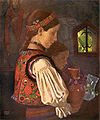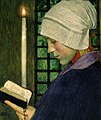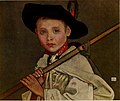Marianne Stokes
Marianne Stokes also Mrs. Adrian Stokes , née Preindlsberger (born January 19, 1855 in Graz , † August 13, 1927 in London ) was an Austro-British painter.
Life
Marianne Preindlsberger first studied art at the Munich Academy under Wilhelm von Lindenschmit . Under the influence of the Munich School , she created early works such as the painting Dreaming Girl from 1875. She later switched to the École des Beaux-Arts in Paris on a scholarship and took lessons from Pascal Adolphe Dagnan-Bouveret . The painter worked in Paris and the surrounding area and found new models in the naturalism of the paintings by Jules Bastien-Lepage and Jean-François Millet . In 1883 she met during a stay in Pont-Aven in Brittanythe English painter Adrian Scott Stokes (1854–1935) know. She married him in 1884 and moved with him to England. Marianne Stoke's painting Reflection , made there, she exhibited in the same year in the Paris Salon . After the painting was presented again in 1885 at the Royal Academy of Arts , the Walker Art Gallery in Liverpool bought it . In 1886 Marianne and Adrian Stokes followed the call of the Irish painter Stanhope Forbes , the founder of the Newlyn School artists' colony , to St Ives in Cornwall , where they received a long visit from Helene Schjerfbeck . Mostly rural genre scenes were created here . In the same year the couple also visited the artists' colony in Skagen on the northern tip of Denmark. ( Michael Ancher's painting “Child Baptism” and a series of photos prove this relationship with the Skagen painters ). Later Adrian and Marianne Stokes lived in different places in England. In addition to regular exhibitions at the Royal Academy, she also took part in 1893 with some paintings at the World Columbian Exposition in Chicago , where she was awarded a medal.
In the 1890s, Marianne Strokes often turned to medieval, religious and mythical motifs in her work. The influence and tradition of the British Pre-Raphaelites and Art Nouveau are clearly evident here. Around the turn of the century, Marianne and Adrian Stokes traveled extensively. A joint trip by the Stokes couple to Ždiar in the Carpathian Mountains was followed by the book Hungary , published in London in 1909 , whose portrait studies of Slovak mountain peasants by Marianne Stokes are also of folklore significance. In 1923 Marianne Stokes became a member of the Royal Society of Painters in Water Colors , later the Royal Watercolor Society .
Works by the artist can be found in London's Tate Gallery , the Wallraf-Richartz-Museum & Fondation Corboud in Cologne and in the public collections of Pittsburgh, Manchester and Wolverhampton.
Selected Works
literature
- Adrian Stokes: Hungary: painted by Adrian & Marianne Stokes London 1909
- Atholl Hill: Aspects of Victorian art London 1971
- Exhibition catalog London: Peintres de l'ame London 1984
- John Christian (Ed.): The last romantics: the romantic tradition in British art, Burne-Jones to Stanley Spencer London 1989 ISBN 0-85331-552-3
- Magdalen Evans: Hungarian journeys: landscapes and portraits, 1905-1910, Marianne & Adrian Stokes London 1996 ISBN 095292210X
- Magdalen Evans: Utmost Fidelity. The painting lives of Marianne and Adrian Stokes , Wolverhampton Art Gallery (exhibition catalog January 30 to April 3, 2009), Sansom & Co, Bristol 2009
Web links
- Marianne Stokes at Victorian Art in Britain (English)
- Wiener Zeitung : Robert Schediwy - Marianne Stokes, a forgotten Styrian painter ( Memento from February 5, 2006 in the Internet Archive )
- Article in Kleine Zeitung, Graz 2009. Kleine Zeitung , February 23, 2009, archived from the original on October 12, 2014 .
- Waiting in the forest. Image from week 4 - January 24th to 31st, 2000 . To "Snow White", Wallraf-Richartz-Museum & Fondation Corboud
- Princess in the forest. Image from week 33 - August 13-20, 2001 . To "Melisande", Wallraf-Richartz-Museum & Fondation Corboud
| personal data | |
|---|---|
| SURNAME | Stokes, Marianne |
| ALTERNATIVE NAMES | Preindlsberger, Marianne |
| BRIEF DESCRIPTION | Austro-British painter |
| DATE OF BIRTH | January 19, 1855 |
| PLACE OF BIRTH | Graz |
| DATE OF DEATH | August 13, 1927 |
| Place of death | London |









